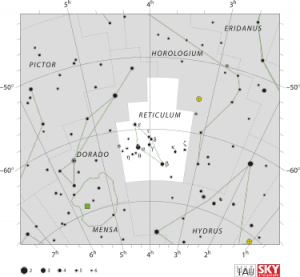Reticulum
Reticulum is a small, faint constellation in the southern sky. Its name is Latin for a small net, or reticle—a net of crosshairs at the focus of a telescope eyepiece that is used to measure star positions.The constellation is best viewed between October and December, but cannot be seen from middle to northern latitudes. Only two of the stars in this constellation are brighter than visual magnitude 5: Alpha (α) and Beta (β) reticuli. The reddish star R Reticuli is a Mira variable. This variable was discovered by C. Ragoonatha Chary at the Madras Observatory in India. The binary star system Epsilon Reticuli consists of a spectral class K2IV star being orbited by a white dwarf. Based on parallax measurements, this system is located about 50 light years from the Sun. In 2000, a planetary companion was announced, orbiting the star ε Reticuli A. Zeta Reticuli is a wide binary star system, with both members being similar to the Sun. It is located at a distance of about 39 light years. This system gained some notoriety in ufology when the alleged alien abductees Betty and Barney Hill named it as the home of their abductors.In 2005, a type 1a supernova was discovered in the spiral galaxy NGC 1559, located in the Reticulum constellation. A constellation in this area was introduced by Isaac Habrecht II in his celestial globe in 1621, who named it Rhombus.It was replaced with a somewhat different constellation by the French astronomer Nicolas Louis de Lacaille in the eighteenth century; during his stay at the Cape of Good Hope, he named the constellation le Réticule Rhomboide to commemorate the reticle in his telescope eyepiece.[4] The name was later Latinized to Reticulum in his star catalogue Coelum Australe Stelliferum.[1]
References
Found in HGS Manual on Page 108
Found in HGS Manual on Page 115
